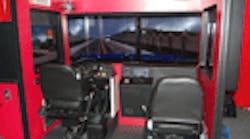See photos from the TCA convention
SAN DIEGO. Suppliers of truck-driving simulator systems are rolling out a variety of enhancements to their products to boost their ability to provide feedback to veterans and trainees alike – especially in terms of correcting bad operating habits.
For example, here at the 2011 Truckload Carrier Association (TCA) convention, Alexandria, VA-based L-3 MPRI showed off its TranSim V truck driving simulator, which now comes equipped with a camera system to record the actions of the driver behind the wheel as he navigates scenarios displayed on the unit’s screen. The simulator also now features 50-in screens vs. the 42-in monitors used on the previous version, the TranSim IV.
The camera system allows for a more direct form of feedback to drivers on their vehicle operating habits, explained Jim Naatz, the company’s vp-sales. Drivers learn whether they check their rear-view mirrors frequently enough and whether they get distracted by events inside and outside the cab.
“We’ll ring their cell phone while their operating the simulator and see if they try to answer it,” Naatz told Fleet Owner. “We’ll program an accident to occur on the other side of the highway and see how much of a distraction that creates for them – how long do they take their eyes off the road.”
The film of the driver’s behavior can then be viewed ialong with the simulation replay, showing the driver the vehicle’s behavior alongside their own conduct behind the wheel, he said.
Doron Precision Systems of Binghamton, NY, takes a slightly different driver-feedback approach with its technology platform. Its 460 Truck simulator – also on display at TCA’s show – features a built-in seat for the instructor right next to the driver’s to allow for more direct skill evaluation.
The key, said MPRI’s Naatz, is to re-create with as much realism as possible actual driving situations drivers face on the highway. For example, the TranSim system can be configured with 140 different transmission types (manual and automatic), 240 engines, 300 tire sizes plus 33 axles ratios to match specific truck configurations and heighten training objectives.
Transducers in the TranSim seat and steering wheel allow the instruction to create road vibration and inhibit steering ability to match vehicle behavior in a tire blowout scenario. Naatz noted that real accident situations can be re-created to a degree, based on police report data, so drivers can get specific, focused training to help them avoid behaviors that can cause certain crashes. And they learn all this without a fleet having to put real equipment at risk on the road just for training purposes.
On top of that, all of the simulation “runs” can be recorded and stored by the fleet, to provide a detailed record of the ongoing training drivers receive, Naatz added.
“We believe within the next 15 years, trucking will be where aviation is today in terms of simulator use,” he added. “As the technology gets less expensive and more capable, fleets will use it to certify and re-certify the skill sets of their drivers.”




